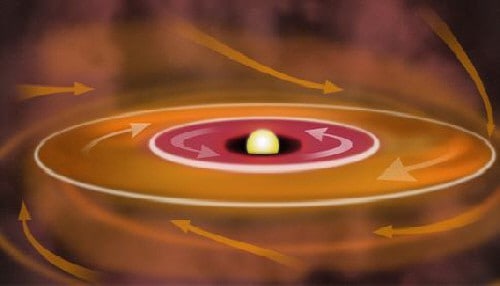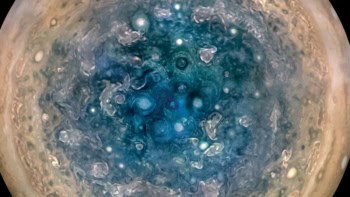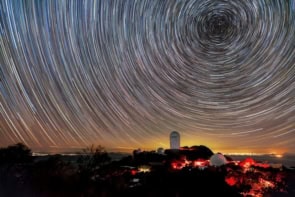Astronomers in the US have discovered that the inner and outer parts of a gas disk orbiting a young star in our galaxy are rotating in opposite directions. This unexpected result means that some of the planets that will form around the star will orbit in one direction, while the other planets will orbit in the opposite direction. In our solar system, in contrast, all planets travel in the same direction. The findings also indicate that the process of star and planet formation from such "protoplanetary" disks could be more complicated than previously thought (Astrophysical Journal to be published).

Many scientists believe that stars and planets are created when giant clouds of gas and dust collapse. As the cloud collapses, a flat, rotating disk of material forms around the young protostar. This protoplanetary disk is the seed material from which planets then form. The resulting planets all rotate in the same direction as the original cloud. This is what happened in our own solar system: all the planets orbit the Sun in the same direction as the Sun itself rotates.
Now, Anthony Remijan of the National Radio Astronomy and Jan Hollis at the NASA Goddard Space Flight Center have found something completely different. Using the Very Large Array radio telescope in New Mexico, the astronomers have observed that the inner and outer parts of a disk around a young star in the constellation Ophiuchus, some 500 light years away, are rotating in opposite directions. According to the researchers, this star may have received its protoplanetary disk from two clouds — not just one — with both clouds rotating in opposite directions to each other.
“This is the first time that anyone has seen anything like this, and it means that the process of forming planets from such disks is more complex than we previously expected,” says Remijan. “In the solar system that will probably form around this young star, the innermost planets will orbit in one direction and the outer planets will orbit in the opposite direction.”
Remijan and co-workers obtained their results by analysing the shifts in frequencies of radio waves emitted by molecules like silicon monoxide within different parts of the cloud as they moved. This Doppler shift reveals the direction in which the gas cloud is moving relative to Earth.



